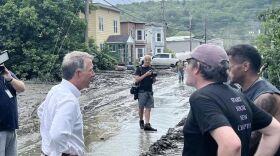Vermont Governor Phil Scott was in Lyndonville, in the state’s Northeast Kingdom, on Wednesday to mark the anniversaries of flooding in the state.
On July 10, 2023, multiple storm systems caused catastrophic flooding in Vermont, inundating towns, villages and the state’s capital city. At that time, Senator Bernie Sanders, an Independent, joined state officials to assure residents that federal resources would be available for recovery
“What we are looking at now are thousands of homes and businesses which have been damaged, sometimes severely. We’re looking at roads and bridges some of which have been wiped out,” Sanders noted at the time.
Exactly one year later, on July 10th, 2024, a storm system again caused more devastating flooding in many of the same areas as the previous year and in new areas like the Northeast Kingdom. The city of Barre was still recovering from 2023’s flood when it was submerged again. At the time, Mayor Thom Lauzon said it was hard to see it happen again.
“It’s tough to watch folks in your community suffer and go through this again. By 5:00 this morning our crews were out cleaning up the mud, cleaning up the debris. We’ve got a lot of work to do,” Lauzon reported at the time.
To mark the anniversary of both floods, Governor Phil Scott and members of his administration met in Lyndonville to tour progress in flood recovery there.
“Instead of throwing up our hands, Vermonters rolled up their sleeves and got to work mucking out basements, delivering meals to neighbors in need and volunteering to clean up homes, neighborhoods and businesses. Long-term recovery groups were formed. As we look back on the floods of the last two summers, we’ve come a long way,” Scott reported.
As Vermonters mark the anniversary of two floods, other states, including Texas and South Carolina, are dealing with catastrophic floods. Scott said he has not yet spoken with Texas Governor Gregg Abbott but said the state will help in any way it can.
“My first reaction was just the sheer devastation, the heartbreak, the loss of kids. It’s every parent’s worst nightmare and I can’t imagine what they’re going through. I was thankful we didn’t have to go through that here, but it could happen anywhere,” Scott reflected. “We’re seeing loss of life in New Mexico and North Carolina as well.”
The anniversary of the floods also comes as federal authorities consider cutbacks to FEMA. Scott is still reviewing the bill passed by Congress to determine potential impacts for Vermont.
“In terms of FEMA I think we’ll learn pretty quickly with New Mexico, North Carolina and in Texas. That will be our test cases, in some respects, as what’s going to become FEMA from here on out. I have a feeling that the response from the administration might be a little different than the rhetoric we’ve been hearing,” Scott postulated, “Because as we’ve all said we need FEMA.
The two floods in Vermont affected more than 150 towns, villages and cities and caused more than $1 billion in damages.
Governor Scott noted that following Tropical Storm Irene on August 28, 2011, it took more than a decade to complete all recovery projects.
Back on the tour surveying parts of Vermont damaged by 2023 and 2024 floods, Lyndonville Redemption Center owner Emily Switser described how the surging flood waters last year destroyed her business.
“By the time the floodwaters receded nearly all our equipment and inventory had been destroyed,” Switser’s voice breaks as she remembers. “The cleanup felt impossible at first, but almost immediately friends, customers, vendors, even complete strangers began showing up. They brought tools, food, helping hands and reminded us that we weren’t alone. This past year has tested us but it’s also reminded us of our resilience, our community strength and how much can be achieved when people come together.”
Scott recalled walking up Red Village Road shortly after last year’s flooding.
"The field down below looked like a log yard, with debris stacked up like cordwood about 25 feet in the air. I saw a somewhat intact but destroyed home pinned against the bridge,” Scott described. “I looked down at what I thought was the road and there was a chrome bumper sticking out, the entire car completely buried in gravel and sediment.”
Scott returned to that site to observe the land being reclaimed. Casella Construction Foreman Brian Rossier described the clean up before turning to Governor Scott.
"When we showed up pretty much at this intersection here there was houses laying in the road. There was cars buried and then from here back the river was now the road and the road was no longer existing.”
Rossier turns to Governor Scott, “ I do have one request.”
“Yeah?” Scott replies curiously.
Rossier tells the governor, “Last time you snuck out. I need you to run that 330 and load that truck!”
Scott laughs, “I could do that.”
“It’s all ready for you,” Rossier tells him. “I’m a hundred percent serious.”
“Okay.”
“Let’s go do it.”
Scott, who owned a construction company before he became governor, got into the cab of the excavator and started working.






























